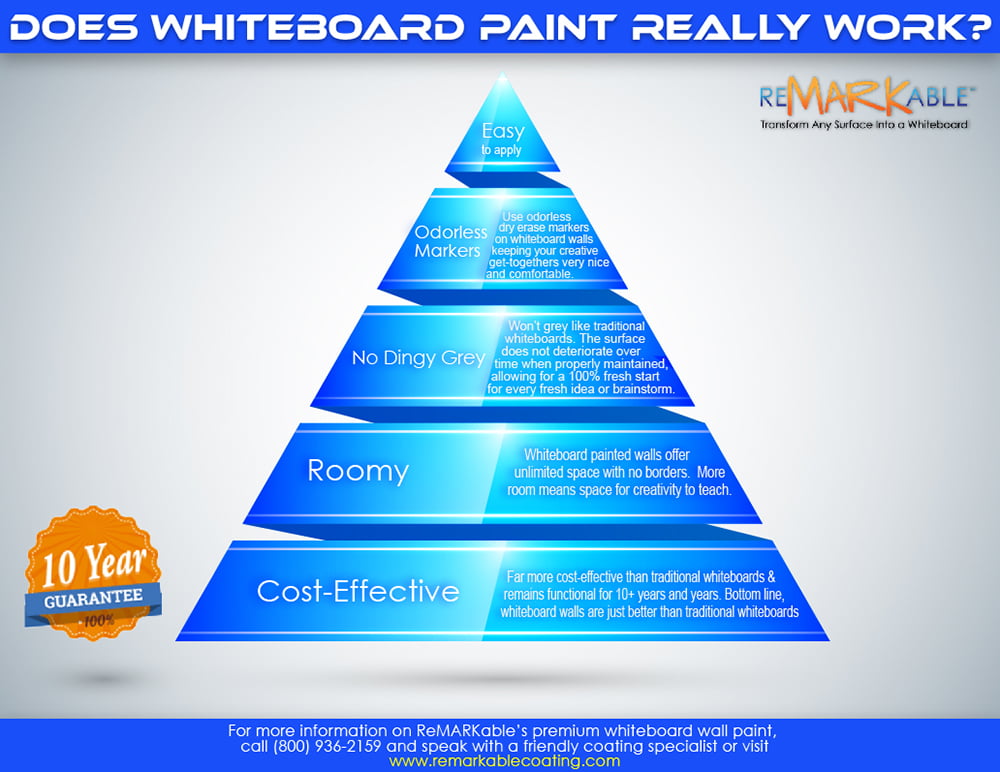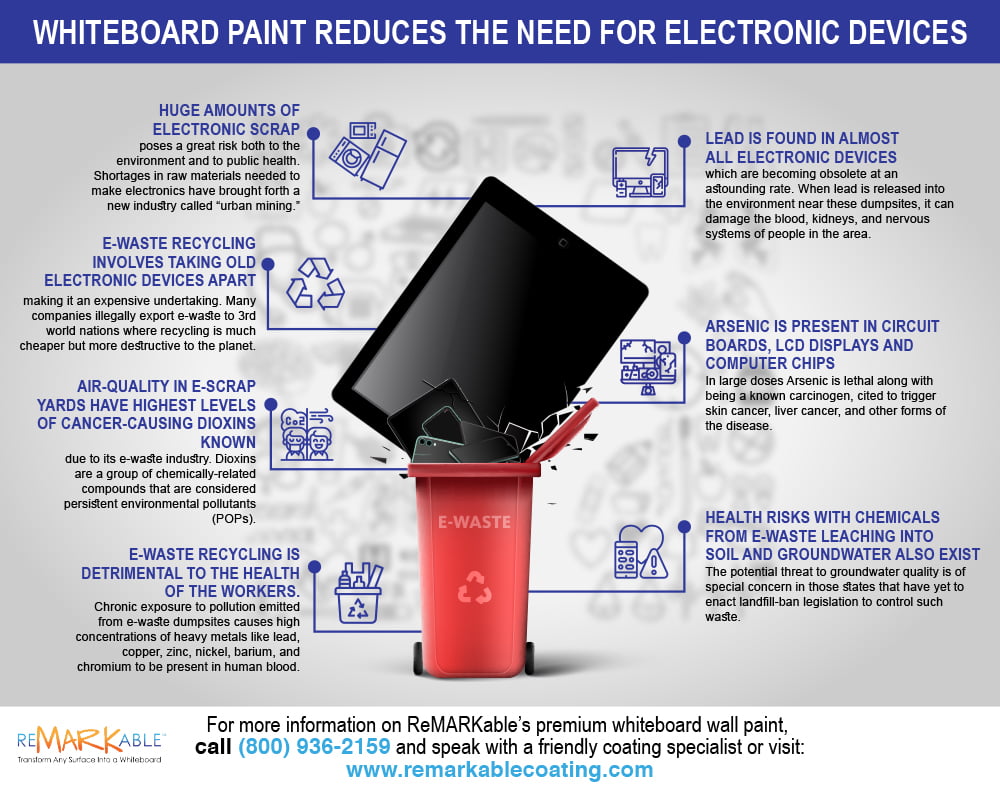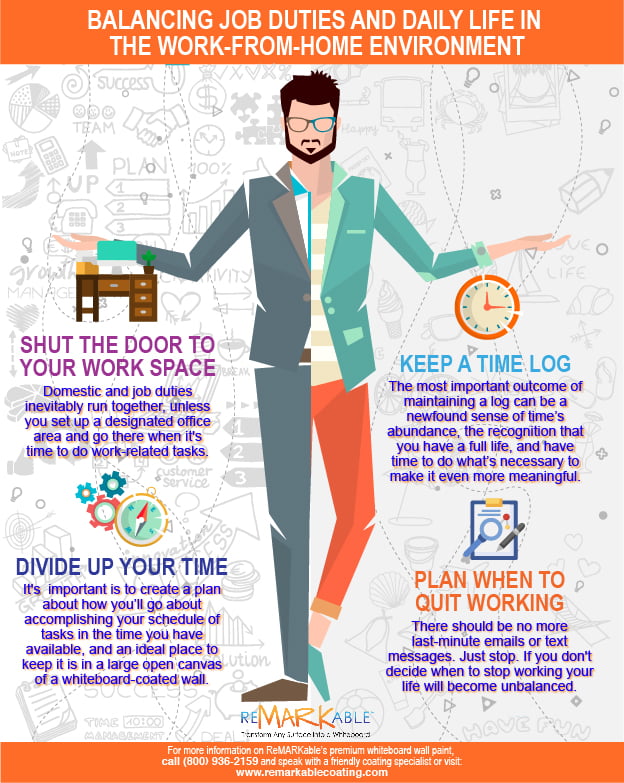
Does whiteboard paint really work?
Yes, it works, and the best quality whiteboard paint lasts longer than typical traditional whiteboards. Chemicals and some solvents in the pens used on whiteboards tend to break down the surface of a traditional whiteboard; thus, the dingy grey discoloration is usually seen within about three years. This causes the need for replacement which can be not only costly but adds more non-biodegradable trash to our landfills. ReMARKable Whiteboard Paint is completely impervious and, when properly maintained, has been reported to look and perform the same ten years later just as it did when originally properly installed.
ReMARKable Whiteboard Paint allows for expanded, seamless collaboration space not obtained by traditional whiteboards because of limitations in the size in which the material may be manufactured. Proper and easy preparation is key. You want your smooth surface to be sealed well with one of the suggested manufacturer’s base paints so that the quality whiteboard coating can be applied on top of the surface and perform optimally and not saturate down into an ill-prepared surface.
In summary, not only does whiteboard paint really work It actually has characteristics that are far more beneficial than the traditional framed whiteboard. Below are just a few.
Ease of Application
The components of our top-quality whiteboard coatings are far superior to those of our competitors, which is clear from the fact that our whiteboard paints require the application of just one coat to be usable, resulting in easy installation and a highly efficient dry time of just 48 hours.
Most other whiteboard paints come in two-part epoxy-based formulas that are high in toxic volatile organic compounds (VOCs) and can be extremely tricky for anyone but an expert painter to apply without problems. However, our premium dry erase products, which consist of an environmentally friendly two-part water-based formula, are simple for even novice painters to mix and install. Besides being easy to apply, if certain spots on your whiteboard painted surface were missed or not done completely during installation and need to be touched up, you’ll notice these areas in just 48 hours, and the repairs can be done right away. With other whiteboard paints, if you detect spots that need retouching, you’ll have to wait for an extra three to seven days for the surface to be useable after the spots are filled in.
Odor-free Markers
It’s best to use odorless or low-odor non-toxic dry erase markers on your quality whiteboard surfaces to ensure that your creative and informative gatherings are pleasant and comfortable experiences for everyone involved. Many people, especially young children and people with respiratory issues are sensitive to the strong chemical vapors given off by many types of dry erase markers, which typically contain a noxious blend of ingredients. One of these components, known as 2-Butanone, is especially hazardous for human health and Earth’s environment. The US Environmental Protection Agency advises that exposure to this compound can cause eye, nose, and throat irritation, and it has also been linked to liver, kidney, nerve, and lung disorders. In addition, research data coming from Princeton University reveals that 2-Butanone can affect the action of the brain, leading to headaches, dizziness, nausea, and even respiratory collapse.
So, for the health, comfort, and safety of your staff, family members, or anyone else who uses or is exposed to your whiteboard painted walls, it’s a good idea to stick with odor-free or low odor markers when writing or drawing.
No Graying of Surfaces
When dry erase markers are used on a standard whiteboard, the board usually looks okay for the first four to eight weeks. But it will soon begin to “ghost” or show gray areas on its surface, causing text and drawings to be hard to see and the board more difficult to use and maintain. This gray, shadowy appearance is caused by dry erase marker ink bleeding into a whiteboard’s surface, which can occur through the use of dirty erasers, the erasing of still-wet marker ink, the use of the wrong kind of marker or a low-quality whiteboard, the repeated heavy use of a whiteboard, or the habit of leaving writings or drawings on a whiteboard for a long period of time.
Antidotes are available to address this problem, but most require several tedious, time-wasting steps that are only short-term fixes and need to be repeated monthly, weekly, or even daily for the lifespan of a whiteboard, which is usually only one to five years. So, whiteboards that have begun to turn gray or ghost are only useable for a limited amount of time, and the process of cleaning the gray areas is slow and labor-intensive. For instance, whiteboard erasers can be thoroughly cleaned by brushing, beating, and vacuuming them; then the whiteboard can be wiped down with the cleaned erasers and a cloth soaked in whiteboard cleaning solution; and finally, the board can be coated with a special spray and allowed to dry before use.
However, these procedures are unnecessary with our high-quality whiteboard painted walls because the problem of ghosting never comes up. With their durable, wear-resistant, smudge-resistant finishes, our surfaces can be wiped clean with just a microfiber cloth and used continuously for ten or more years without needing to be replaced. In fact, all of our products come with a ten-year warranty assuring that they will not divide into layers, peel, crack, or “yellow” and will resist staining and fading when properly applied, cleaned, and maintained in accord with instructions and used with suitable dry erase markers.
Unlimited Space
One of the main features that make high-quality whiteboard walls different from traditional whiteboards is the immense surface areas they provide for writing, drawing, or random doodling, thus affording the chance to present details, images, and facts in a clearly visible format with limitless room for expression. Whiteboard painted walls can be as large or as small as you wish in your meeting room, office, classroom, conference room or other areas while conserving valuable space because they eliminate the need for standard whiteboards, which are typically 4’-5′ high x 6’-12′ wide and protrude about 1 ½ to two inches into a room. Thus, standard whiteboards consume a great deal of space but still have limited surface areas on which to express ideas and information and foster creativity. Whiteboard-painted dry-erase boards, by contrast, are high and wide, creating virtually unlimited prospects for use without taking up extra area in a room or hallway. When we’re indoors, walls are all around us, so why not take advantage of these unused spaces and bring them to life with top-quality whiteboard coatings, thus freeing up your mind and the minds of your staff to explore and create new ideas without limits?
Covering the walls of your home, office, clinic, or other areas with premium whiteboard paint allows you to renew and elevate your typical ways of thinking and working. By setting down your thoughts, dreams, proposals, and random creative insights on surfaces that are as vast as your ingenuity, you’ll find yourself operating in ways that you never imagined. The large open area of a whiteboard painted wall will liberate your psyche and encourage new ideas to take seed, germinate, and mature, whether they’re related to work, domestic activities, recreational pursuits, or other interests. Whiteboard walls have been found to enhance employee and student output, efficiency, and creative thinking in countless business and academic settings around the globe, and they’re certain to have the same effect on you and others in your school, home, office, or organization.
Cost-Effectiveness of Whiteboard Paint
Besides the immense areas they offer for writing, drawing, and doodling, another major quality that makes premium whiteboard surfaces superior to traditional whiteboards is their great cost-efficiency. Whiteboard painted surfaces are as large as the walls of your meeting room, office, clinic, gym, classroom, or other workspaces. However, traditional whiteboard boards are limited to specific dimensions, so you’re restricted with respect to how much writing and drawing surface you can install. Creating a bigger surface on which to work would require covering your walls with multiple whiteboards, which would be unattractive and costly, as the price of a standard 4′ x 6′ whiteboard can be as high as $200. Instead, with whiteboard paint, you can transform entire walls into whiteboard surfaces for a fraction of the cost and have great spaces on which to brainstorm ideas, create word lists, draw flow charts, make mind maps, and the like. This attribute of cost-effectiveness combined with massive areas on which to write and draw is highly appealing to business owners, directors of organizations, and heads of households, as they get practically unlimited chances for expressing creativity at a low price per square foot.
Also, the 48-hour dry time of our premium dry-erase coatings, the fastest on the market today, adds to their cost effectiveness, because it allows for a quick return to work and less time wasted in avoiding freshly painted walls or relocating an entire office while waiting to use a whiteboard coated surface.
The post Does Whiteboard Paint Really Work? appeared first on ReMARKable Whiteboard Paint.
source
https://www.remarkablecoating.com/does-whiteboard-paint-really-work/




